Tea in April
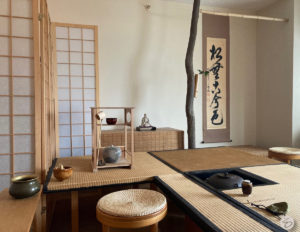
Following the principles of a particular tradition or school influences those choices. In modern times decoration and adornments that reflect the seasons is of greater importance than in the past. Choosing various objects for special reasons, creates an atmosphere that can be unexpectedly meaningful. It should be remembered that when choosing the utensils that they are appropriate for the guest. The tori–awase in the picture has a deep significance for the host.

Kake-jiku, 掛軸, hang-scroll; ‘Matsu [ni] ko-kon iro nashi,’ 松無古今色, Pine no past present form, written by Oku-da Yuki-o, 奥田行朗, Inner-ricefield Transition-son [1911-1999], 58th abbot of Ō-baku-san Man-puku-ji, 黄檗山萬福寺, Yellow-oak-mountain Ten thousand-fortune-temple, U-ji, 宇治, Heaven-reign, Kyōto.
The hyō-gu, 表具, front-tool, mounting, is very simple, and in a typical Chinese style, with ichi-mon-ji, 一文字, one-letter-character, and chū-mawashi, 中廻し, middle-surround, which is under the influence of In–gen, 隠元, Conceal-beginning, the Chinese priest who founded Manpukuji in 1661.
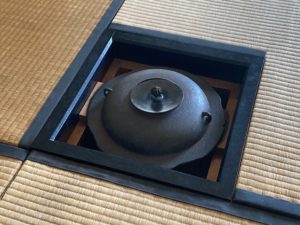
In the early days of the ro, the size of the ro was built to accommodate a kama. The kama may have come from a temple, and was quite large, so the size of the ro varied. It was Rikyū who established the size of the ro opening at fourteen sun kane-jaku, and the size of the opening in the rodan at one shaku kane-jaku, or eight sun kujira-jaku, which allowed the use of most kama. The measurement between the insides of the robuchi is 11.6 sun kane-jaku or 9.28 sun kujira-jaku.
Rikyū felt that having only one kama was sufficient to make Tea. Following Rikyū’s thought, if one had a sukigi-gama, it can be used throughout the season. Traditions, such as Urasenke, use the sukigi-gama in April. There might be a question regarding the reason for having a sukigi-gama
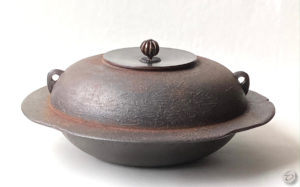
The kama and the hane have the same numbers of 8.5, but of different means of measurements, kane and kujira. They relate to each other 8:10. The lid knob, tsumami, 摘み, pinch, is a sphere formed by ten petals of a kiku, 菊, chrysanthemum. There is a very small eighteen-petal chrysanthemum washer on the top of spindle that holds the knob to the lid. The escutcheon, za, 座, seat, on the lid itself is in the form of a twenty-four-petal chrysanthemum. A popular family crest is a mitsu-wari-giku, 三割菊, three-divide-chrysanthemum, that has a wide variety of designs. Various kinds of chrysanthemum have been played various roles in Asian culture, including a chrysanthemum tea that has been a familiar medicinal tea in China for thousands of years. The presence of a chrysanthemum on the lid of the kama may enhance the healthful qualities of the tea.
A kettle used in April is the suki-gi gama, 透木釜, pass through-wood kettle, which has a wide flaring flange that is rested on a pair of small wooden blocks called sukigi. This type of kettle is used with the ro, 炉, hearth, and a similar, but smaller kettle, is used with the fu-ro, 風炉, wind-hearth.
In the Jaina faith, the only things that an ascetic may have is a feather whisk, ho-ssu, 払子, which suggests the hane, 羽, feather or wing flange of the sukigi gama, a vessel of water, and sacred scriptures.
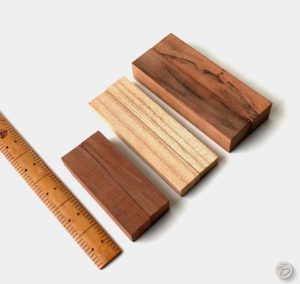
From Left: kane-jaku, 曲尺, bend-span, mono-sashi, 物差, thing-distinction, bamboo ruler.
Pair of cherry wood sukigi for furo – length is 2.9 x .6 x 5.5 sun kane-jaku.
Pair of thin, cedar wood sukigi for ro – length is 3.9 x .7 x .35 sun kane-jaku.
Pair of cherry wood sukigi for ro – length is 3.9 x .8 x .7 sun kane-jaku.
The thickness of a stacked pair of thin sukigi is equal to the thickness of one of the cherry wood sukigi.
The measurement between the walls of the inside of the robuchi is 11.6 sun kane-jaku. The length of the ro sukigi is 3.9, which is approximately one/third the measurement of 11.6. Dividing 11.6 into thirds results in a length of 3.86666 to infinity. The difference between 3.8666+ and 3.9 is .0033 sun kane-jaku.
The following utensils are shown in the picture of my Tearoom, Garandō:
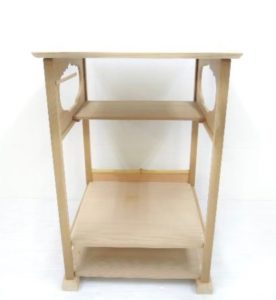
A bamboo kugi, 釘, nail, is located on the near left post for hanging a ha-bōki, 羽箒, feather-brush, and shi-fuku, 仕覆, work-cover. The ‘half-moon’ bamboo nail may indicate that the post is metaphorically located in the east, which affirms the changed location of the teishu in the north.
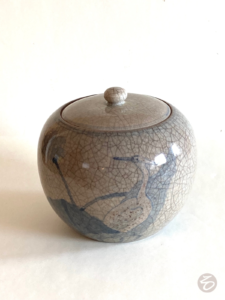
Rikyū’s maternal grandfather, Sen-ami, 千阿弥, Thousand Praise-increase, was Korean, and from whom that Rikyū took the name, Sen. He was a member of the Muromachi shogunate of Ashikaga Yoshimasa. The name ami usually indicates a connection with Amida.
One of the major events in the fourth month is Hana Matsuri, 花祭, Flower Festival, which occurs on the 8th day. Because that time is when the cherry blossoms are often at their peak, many believe that the flower of the festival is the cherry, sakura, 桜. The actual flower is the lotus, hasu, 蓮. The lotus usually blooms in July and August, so the association is elsewhere, with the Buddha. The Buddha was born on the 8th day of the 4th moon.
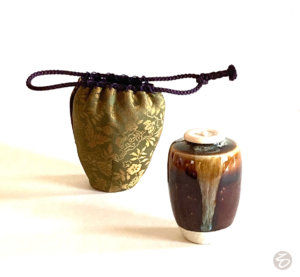
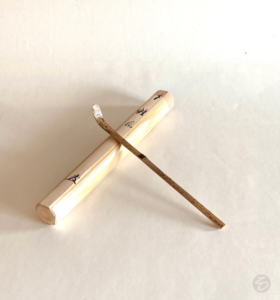
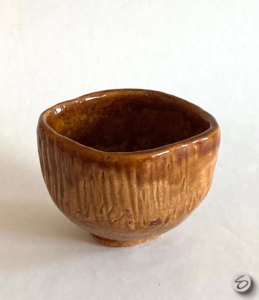
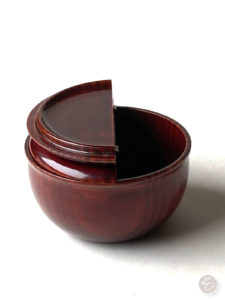
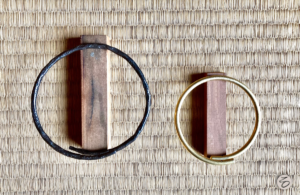
The diameter of the regular kan and the ōkan have the same measurement of 2.8 sun, except that the ōkan are measured with the larger kujira-jaku. The kan relate to each other 8:10, which is a manifestation of ya-ta, 八咫, eight-span, as with the sacred Shintō ya-ta kagami, 八咫鏡, eight-span mirror, a symbol of infinite vastness. The number 2.8, as a diameter, has a radius of 1.4 sun or 14 bu. The number 14 is found in the length of the hishaku, the distance between the center of the furo and the center of the mizusashi, the size of the ro, etc.
The diameters of both kan appear to be very similar to measurements as the lengths of the sukigi. There may be a possibility that there may have been an error in the measurements when the object was made.
The length of an ōkan straightened is 9.5 sun kujira-jaku. The length of the handle of the standard hi-shaku, 柄杓, handle-ladle, is 9.5 sun kujira, which is the same length as the straightened ōkan. The straight handle is Yō, penetrative, and the circular kan is In, receptive. However, the kan is open-ended so that its pointed ends can penetrate the hole in the lugs of the kettle, and becomes Yō.
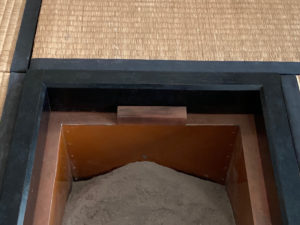
The width of the revealed top surface of the rodan is 9.3 sun kujira-jaku or 11.6 sun kane-jaku. The length of the sukigi is one/third the width of the revealed rodan, 3.1 sun kujira-jaku or 3.9 sun kane-jaku. Wood for the sukigi includes sakura, 桜, cherry (as pictured above), ho-o-gashiwa, 朴, a kind of oak; ume, 梅, prunus; sugi, 杉, cedar; etc.
Sukigi for the ro measure 3.1 x .64 x .55 sun kujira-jaku or 4.875 x .8 x .687 sun kane-jaku. The most significant aspect is the .8 sun kane-jaku, evoking the concept of Infinity in Space.
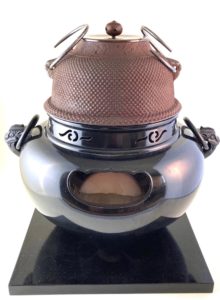
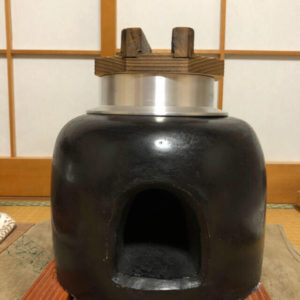
There is a major consideration regarding the use of the sukigi. The original support for the kama was the furo, which was made of iron or bronze, where the kama rested directly on the upright collar, koshiki, 甑, of the furo. The original and most authentic ro, the sunken hearth, was made of material just like the structure of the teahouse itself. The old Kanji for ro is, 爐, which is composed of the Kanji for fire, hi, 火, and the Kanji for ro , 盧, hut. That is with tsuchi-kabe, 土壁, earth-wall, made of clay and straw with a sand surface. It is this type of ro for which was and is necessary to use some material that will protect the delicate earthen walls of the rodan from the heat of the iron kama flange. This was the origin of the wooden sukigi. In practice, there is no real need of sukigi if the rodan is made of metal, such as the copper rodan pictured above. Custom and tradition prompt one to use sukigi nevertheless. As the standard sukigi are not exactly square in section, it may be so that one can make slight adjustments in the height of the kama. It is thought that there should be enough space to put one’s finger between the hishaku resting on the kama where the handle crosses the heri, binding of the tatami, and the handle tip to rest on the tatami.
The width of the top surface or shoulder of the rodan is 2 sun kane-jaku. The width of the ro-buchi that surrounds the hearth opening and top of the frame is level with floor is 1.2 sun, leaving .8 sun, or 8 bu, 分, for placing the sukigi. The width of the sukigi is 8 bu or hachi–bu, 八分, is a homonym of hachi–bu, 八部, eight-legions, which refers to the eight groupings of various Buddhist deities.
When searching for the word hachibu on the internet Kanji source, Jisho, the first listing refers to the group of eight Buddhist deities, which indicates the word’s importance in general Japanese language. The hachibu measurement is the second listing.

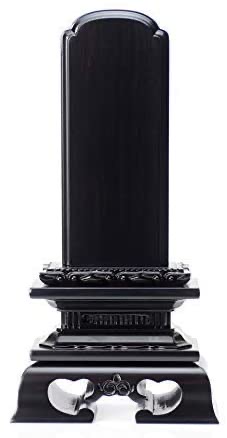
Left: shira-ki, 白木, white-wood 8 x 1.8 x .264 sun kane-jaku: full height with base is 9.5 sun kane-jaku. Right: kuro-nuri, 黒塗, black-lacquer, i-hai, 位牌, rank-tablet, without gilded inscriptions: full height is 5.125 sun kane-jaku.
The sukigi may be identified with the plaque of an i-hai, 位牌, rank-tablet, a mortuary spirit tablet. This temporary ihai is a thin, rectangular piece of plain wood, called a sane–ita, 札板, placard-board, which has the deceased’s name and specific dates, and is supported upright on a base.
The measurements of a standard shiraki saneita are 8 x 1.8 x .264 sun kane-jaku. The full height with base is 9.5 sun kane-jaku, which is the length of the standard hi-bashi, 火箸, fire-rods, used to build the fire in Chanoyu.
The height of the ihai is, in part, determined by the height of the placard, satsu-take, 札丈, placard-height, which varies from 3 to 6 sun, and in increments of five bu.
The first memorial placard or ihai that is used after a Buddhist person dies is the shira-ki, 白木, white-wood, which is a plain wooden plank. The name and dates of the deceased are written on the board in ink with a brush. This is replaced by a plank of wood finished with black lacquer with incised characters covered with gold leaf. This permanent ihai should be accomplished by professionals before the seventh week after death, which is forty-nine days. In Japanese, this is written 七七日, seven seven-day, which is read in various ways, including shichi shichi nichi. Seven is a highly significant number filled with symbolic associations. Doubled seven has even deeper significance, especially in Buddhism.
The measurements of commercial ‘3-sun’ satsu are 9 x 4 cm, which is equal to 3 x 1.3 sun kane-jaku. This is the same as the length of the sukigi for a furo sukigi-gama.
The measurements of commercial ‘4-sun’ satsu are 12 x 4.9 cm, which is equal to 4 x 1.65 sun kane-jaku. These ihai satsu measurements are exactly the same as the pair of sukigi placed side by side.
Perhaps it is merely coincidental that the pair of sukigi resembles an ihai that has been divided in half. However, the Buddhist sanctity of the ihai is in harmony with the Buddhist aspects of Chanoyu. Sukigi are made of various woods and are unfinished. The majority of ihai are made of wood, and usually lacquered black with incised gold-filled inscriptions. Some are entirely covered in gold leaf, and can be elaborately ornamented, and even with double doors. Some ihai are plain unfinished wood.
The Tō-gu-dō, 東求堂, East-request-hall, of Gin-kaku-ji, which includes a worship hall dedicated to Amida, has a cabinet that is for keeping a large collection of ihai. It is no coincidence that Japan’s first yojōhan for serving Chanoyu, should be part of a building that is based on the ideals of Amida’s Goku-raku, 極楽, Utter-pleasure. The Tōgudō was built for Ashi-kaga Yoshi-masa, 足利義政, Foot-advantage Loyal-govern to practice and study the Buddhist sect of Jō-do, 浄土, Pure-land, and the worship of Amida.
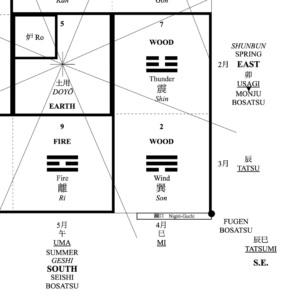
Diagram of the Southeast corner of a yo-jō-han, 四畳半, four-mat-half, with influences that may be present.
The guests, other than the shō-kyaku, 正客, correct-guest, are seated on a tatami that is identified with Moku, 木, Wood, one of the Go-gyō, 五行, Five-transitions, five physical elements, and which is symbolic of life and growth.
The basic directions are guarded by eight Buddhist deities, which are different from the above eight groups of deities. North – Sen-jū-kan-non, 千手観音, Thousand-hand See-sound; Northeast – Ko-kū-zō, 虚空蔵, Empty-void-treasure; East – Mon-ju, 文殊, Literary-particularly; Southeast – Fu-gen, 普賢, Universal-wisdom; South – Sei-shi, 勢至, Strength-attain. These five deities are Bodhisattvas, Bo-satsu, 菩薩, Sacred tree-buddha, transitional to become Buddhas. The other deities are located variously; Southwest – Dai-nichi Nyo-rai, 大日如来, Great-sun Like-become; West – Fu-dō Myō-ō, 不動明王, Un-move Bright-king; Northwest – A-mi-da Nyo-rai, 阿弥陀如来, Praise-increase-steep Like-come.
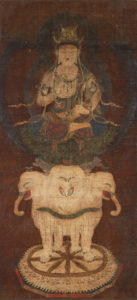
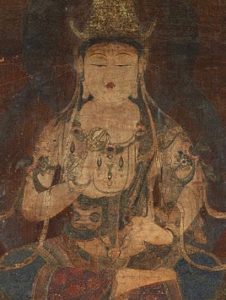
Fugen seated on a three-headed, white elephant: detail showing Fugen holding the go-ko-sho, 五鈷杵, five-cobalt-pestle, in his right hand, and the san-ko-rei, 三鈷鈴, three-cobalt-bell, in his left hand. The implement, with three talons and the bell, suggests, perhaps, the gotoku and kama.
Fugen is depicted sitting on a lotus pod surrounded by petals, which is a familiar device for most Buddhist deities. Fugen holds various objects. One in particular is a go-ko-sho, 五鈷杵, five-cobalt-pestle, which is based on the vajra, a metal implement that has talons at both ends. The gokosho is held by innumerable Buddhist deities, and it is the prime emblem of Tai-shaku-ten, 帝釈天, Emperor-Buddha-heaven, king of the gods, and his lightning bolt.


Left: san-ko-rei, 三鈷鈴, three-cobalt-bell. Right san-ko-sho, 三鈷杵, three-cobalt-pestle.
The gokosho is composed of a shaft that is pointed at both ends, and each of the points is surrounded by four curved talons, thus creating five points. Some gokosho have all five points joined at the tips which is symbolic of peace, whereas with the points open, the object is regarded as a weapon. The three prongs of the tripod of the gotoku are called tsume, 爪, talon.
The eight guardian Buddhist deities are also identified with twelve animals of the Asian zodiac, as well as the twelve months. For the present study, the subject is limited to Fugen who is the guardian of the Southeast and the zodiac signs of Tatsu-Mi, 辰巳, Dragon-Snake. The word tatsumi is also written 巽, which is also read son, and means both Southeast as well as obedient and modest. Son, one of the eight trigrams of the Eki-kyō, 易経, Change-sutra, is located in the Southeast on the old arrangement, and the ha-kke bon, 八卦盆, eight-signs tray.
The reason why the kama is held over the ro, may have something connections with Fugen, dragons and snakes, or even directions. Perhaps the attributes of Fugen could provide some connections. Fugen is often depicted riding on a great white elephant, haku-zō, 白象, which is an animal greatly revered in India. Why not a dragon as does Kannon who rides a dragon? Or a snake?
There is a major moment in Fugen’s life that may relate to the sukigi-gama. In India, Fugen was named Samantabhadra, in Sanskrit meaning Universal Worthy, who was a devout Jain, and was revered as a saint. He was afflicted with a disorder that cause to him have insatiable appetite, and ate voraciously. He went into seclusion in a temple, practiced austerities, read sacred Jaina texts, and prayed to an image of Chadraprabha for relief and to cure his disorder. Chadraprabha is identified with Ga-kkō Bo-satsu, 月光菩薩, Moon-light Sacred tree-buddha, the Buddhist deity of the moon. He was cured. Perhaps Fugen’s association with food, makes the connection with the sukigi-gama that has its origins in the meshi-gama/rice cooker. Fugen is the guardian of the third and fourth month, which is the time when the sukigi-gama is used to make Tea.
Implements that accompany Jaina asceticism are limited to a feather whisk, picch ī, [habōki], an implement of compassion, a water-pot, kama õç alu, [mizusashi – kama], an implement of purity, and scripture, sastra, [spiritual text of kakemono], an implement of knowledge. The unryū gama may represent the ascetic’s water vessel. Is it possible that the Sanskrit word kama became connected with the kama of Chanoyu?
Fugen helps others to cross the ocean of samsara, the cycle of birth and death. He guides during Panch Kalyanaka, the five most auspicious moments in life: 1. Entering mother’s womb. 2. Birth. 3. Renounce earthly possessions 4. Attains omniscience. 5. Liberation and become Enlightened.
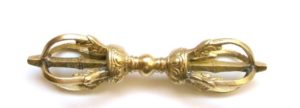
Of these eight Buddhist deities associated with the directions, those that hold a gokosho are limited to the Bosatsu, as Dainichi and Amida rarely hold any implement. Those Bosatsu that hold a gokosho are Senju Kannon and Fugen. It should be noted that Monju also carries a vajra, but it has three prongs, san-ko-sho, 三鈷杵, three-cobalt-pestle, and a bell on the other end of the vajra. Is it possible that Fugen’s double prong-ended gokosho represents two gotoku, one for the March tsuri-gama and the April sukigi-gama?
There is a possibility that this theory is wholly unfounded, as Monju’s three-prong and bell vajra, san-ko-rei, 三鈷鈴, three-cobalt-bell, could represent the three-prong gotoku and kama. However, the vajra and the bell are connected, whereas Fugen’s vajra approximates two gotoku. The gokosho is said to bring good fortune and prosperity, which is called go-toku, 五徳, five-fortunes.
The word toku, as in gotoku, may be wordplay on other Kanji: toku,得, means gain, get, find, earn, acquire, can, may, able to, profit, advantage, and in Buddhism means rebirth in paradise, entering nirvana Buddhism. The latter being the most significant in this context. There is in Buddhism the Hasu no Go-toku, 蓮の五徳, Lotus’s Five-virtue.
The gokosho / vajra represents the lightning bolt of Taishakuten. Chain lightning is a form of lightning that moves rapidly in a zigzag path with divided ends, or abruptly from cloud to cloud. The tsuri-gama may be hanging from a metal chain, kusari, 鎖, or a bamboo pole, take ji-zai, 竹自在. The word takejizai may evoke ta-ke-ji-zai-ten, 他化自在天, other-change-self-presence-heaven, which is the Buddhist heaven of controlling others’ emanations. Takejizaiten is a Buddhist concept that is an important part of the nature of existence, and is the sixth of the Roku-yoku-ten, 六欲天, Six-desire-heaven, Dai-ji-zai-ten, 大自在天, Great-other-change-self-presence-heaven, is a name of Shiva, who is one of the three great deities of the Hindu Trinity. These supreme deities are Brahma, the creator, Vishnu the preserver, Shiva, the destroyer.
Perhaps the association between the uses of the kama in third and fourth months have some connections with Buddhist observances. Because of the variances between the solar and lunar calendars, it is possible that one observance that could be associated with the third month / March is the Vernal Equinox, Shun-bun, 春分, spring-divide, called Hi-gan, 彼岸, Other-shore, which is an important Buddhist event equating it to entering the Pure Land paradise of Amida. An important Buddhist event in the fourth month is the birth of the Buddha, Kan-butsu-e, 灌仏会, Libate-Buddha-meeting. The moon on the eighth day is a half-moon, han-getsu, 半月.
For additional study on these topics, see also: Furo to Ro, April in Japan: Following Elephants, April and Uzuki, Chashaku and Taishakuten

